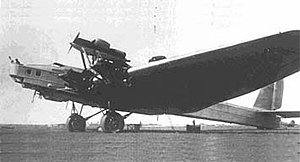|
Tupolev ANT-16
The Tupolev ANT-16 (also known as the TB-4; Russian: Тяжелый Бомбардировщик – Heavy Bomber) was an experimental heavy bomber aircraft designed and tested in the Soviet Union in the early 1930s. Design and developmentConceptually representing evolution of the TB-3 bomber, the ANT-16 was designed under the doctrine that size and payload were more important for a bomber than speed because it would be able to protect itself with defensive armament.[1] The twin 5 by 1.8 by 1.8 metres (16.4 ft × 5.9 ft × 5.9 ft) bomb bays were the largest in the world at that time and presented many design challenges in order to preserve structural rigidity of the airframe.[1] The sole prototype first flew on 3 July 1933 with M. M. Gromov at the controls. The test flight program was completed by 29 September 1933 with disappointing results. The two top-mounted engines performed poorly and a significant portion of thrust generated by the wing-mounted engines was absorbed by the two meter-thick (6 ft 7 in) wing. A proposal to re-equip the aircraft with Mikulin AM-35 engines of 933 kW (1,250 hp) was not implemented.[1] A second prototype was under construction, but was never finished[2] (construction stopped 2 July 1933); some of its parts were used in the ANT-20. Specifications (ANT-16) Data from The Osprey Encyclopedia of Russian Aircraft 1875-1995 [3] General characteristics
Performance
Armament
See alsoRelated development
ReferencesWikimedia Commons has media related to Tupolev ANT-16.
|
||||||||||||||||||||||
